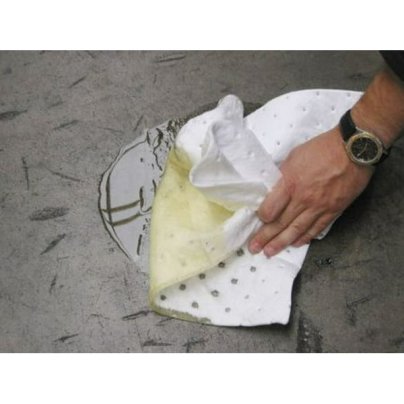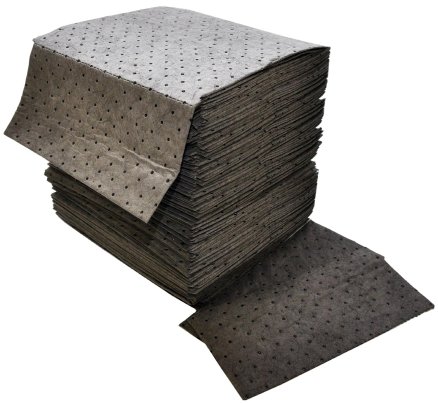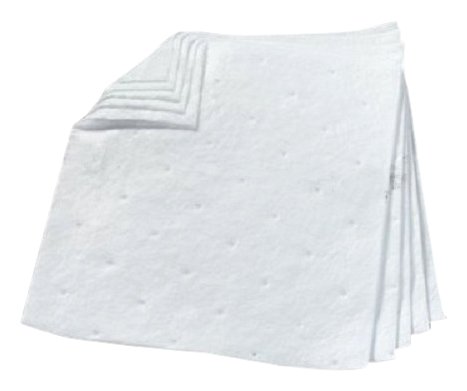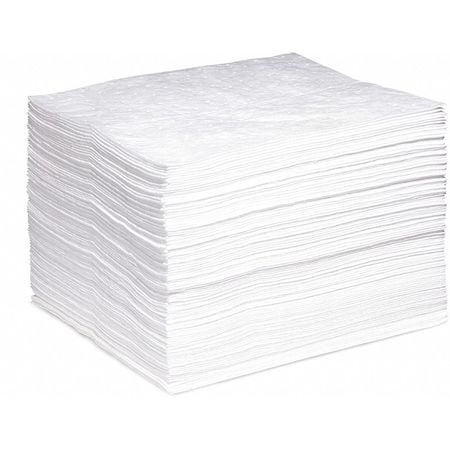
When you’re working under the hood, things can get pretty messy. Bleeding brake lines, adding lubricant or grease, and even your regular oil changes can all leave behind one hard-to-clean mess. Instead of dealing with the aftermath or letting your garage floor take all of this dirty abuse, you can make cleanup a breeze by keeping a stash of oil-absorbent pads on hand. These single-use pads are designed to catch oil and other slippery or messy substances, helping you mop up once your work is finished. Made to handle any job, oil-absorbent pads can be a big help when you’re in the midst of any automotive maintenance or repair job. I’ve rounded up some of the best disposable oil-absorbent pads right here.
Our Methodology
In order to choose the best oil-absorbent pads available, I used The Drive’s methodology and focused on disposable pads that can be used to catch leaks or clean up. I looked for pads that offer good absorbency for automotive fluids such as oil, coolant, and gasoline. The stronger and more versatile a pad was, the better I rated it in my selection process.
Product selections, rankings, and awards for this story are based on research. While I haven’t conducted real-world testing on all of these products yet, I’ve looked at consumer testimonials and data, tutorials, and general discussions on social media and in forums. I also consider price and specification in the context of these pads. Of course, I also rely on my institutional knowledge of the automotive landscape to weed out weak products.
Best Oil-Absorbent Pad Reviews & Recommendations
Best Overall
Brady SPC Basic Oil-Only Absorbent Pad
Best Value
Spilfyter Double-Weight Absorbent Pad
Honorable Mention
3M Petroleum Sorbent Pad
Most Durable
New Pig Oil Mat Oil-Absorbent Pads
Best Heavy-Duty
NPS Spill Control Extra-Heavy Absorbent Pad
Best Lightweight
Spilltech Absorbent Pad
Best Reusable
Moose Racing Oil-Absorbent Pads
Most Versatile
DripPansUSA Oil-Absorbent Pads
Our Verdict on Oil-Absorbent Pads
The best overall oil-absorbent pad is the Brady SPC Basic Oil-Only Absorbent Pad, which delivers a strong combination of high absorbency and the ability to absorb oil-based fluids. If you’re looking for value, the Spilfyter Double-Weight Absorbent Pad is a thicker two-ply pad that can offer absorbency.
What to Consider When Buying Oil-Absorbent Pads
In order to find the highest-quality and most reliable products, consider a few key features and details as you shop. Here’s all of the advice you need right here.
Types of Oil-Absorbent Pads
Single-Use Pads
The most common type of oil-absorbent pad are single-use pads, which are designed to be used once and then thrown away. These pads are convenient, because you can grab them when an unexpected leak pops up or use them to wipe off oil-covered parts and tools. Available in an array of ply choices, however, they aren’t the most environmentally friendly option, as they do create more waste.
Reusable Pads
Reusable oil-absorbent pads are a bit more expensive than single-use pads, but you can clean up messes and sop up oil (and other automotive fluids) just like you can with disposable ones. Once the pads are full, wring them out to remove fluids and let them dry. Reuse them the next time you’re working with leaking liquids. They’re a good choice as a more eco-friendly product but are more expensive.
Oil-Absorbent Pad Key Features
Thickness
The first thing to consider when shopping for quality oil-absorbent pads is the thickness of the pads. Some pads are made of a single ply good for cleaning up or catching messes as they happen. Other pads are two-, three-, or even eight-ply thick or more. The thicker an oil-absorbent pad is, the more fluid it’s able to absorb and carry. If you’re planning to use these pads for big messes or leaks, thicker is better. However, two- or three-ply pads should be fine for daily cleanup.
Capacity
No matter how thick a pad might be, not all pads are capable of holding a lot of liquid. Some can absorb just a few ounces, while others can hold gallons of liquid. If you need a more heavy-duty pad, look for a higher capacity per pad. If you’re simply in need of an everyday oil-absorbent pad, lower capacity should be just fine.
Size
While oil-absorbent pads are typically sold in packs by the hundreds, each pad can vary in size. Some are the size of a standard sheet of paper, while others are larger and able to be used on the garage floor. Consider how you plan to use your pads when choosing a size. Small pads are best for wiping or cleaning, while larger pads are best for catching leaks or drained fluids.
Oil-Absorbent Pad Benefits to Know
Easy to Use
Forget about keeping a stash of old towels nearby; oil-absorbent pads are even easier to use. When you’re working with difficult-to-clean substances such as oil, transmission fluids, and fuel, oil-absorbent pads make it easy to catch spills and clean up messes. They’re convenient and lightweight, and they’re perforated so you can tear off pads just like you would paper towels. Plus, with many pads sold in bulk, you will have plenty on hand.
Keeps Your Garage Clean
Your garage floor and other surfaces can get messy when you’re dealing with cars and motorcycles. Whether you’re worried about setting oily tools and parts on your shop surfaces or need to catch a leak, these pads are specifically designed to absorb oil and other automotive fluids, and you can lay them out to keep every surface you need covered clean. If you put them on your garage floor while you work, you can prevent stains and unsightly discoloration over time.
Affordable
You don’t have to spend a lot to clean up with oil-absorbent pads. These pads are typically sold in large bulk packs with 50 to 100 pads each at an affordable price. You can spend a reasonable amount and get plenty of oil-absorbent pads for your work now and months into the future. While reusable pads are more expensive, they can save you cash over time.
Oil-Absorbent Pads Pricing
Packs of 100 disposable, single-use pads can be had for $30 to $50. However, if you’re looking for something specialized, such as heavy-duty or two- to three-ply pads, you might spend between $70 and $100. For reusable oil-absorbent pads, you’ll find packs of three to six pads for $10 to $25.
Tips and Tricks
As with something you do for decades, you pick up a few tips and tricks along the way in terms of selecting the right product and/or using it. That’s the case with us and oil-absorbent pads. To help you bridge the information gap, here’s a selection of what we’ve learned along the way.
- When you’re looking at the total absorbency of oil-absorbent pads, check whether the total is per pad or per box. For example, a box of pads may hold up to 20 gallons, but a single pad will hold much less.
- Not all oil-absorbent pads can be wrung out, so double check the instructions for use if you’re opting for reusable pads. You may need a different cleanup method before the pads can be used.
- Many oil-absorbent pads repel water, which means they aren’t all-purpose cleanup pads. If you do want water absorption, check the material and product details closely.
FAQs
You’ve got questions. The Drive has answers.
Q: Do oil-absorbent pads work?
A: Oil-absorbent pads are designed to soak up or wipe away oil and petroleum-based products. These pads aren’t usually effective on water spills or leaks, although some can handle water. Many even repel water. But when it comes to other oil-based fluids, they’ll have you covered.
Q: What are oil-absorbent pads made of?
A: Most commonly, oil-absorbent pads are made from some form of polypropylene. Some are made of metal-blown polypropylene, woven with very thin fibers or polypropylene or are 100 percent polypropylene.
Q: How do you dispose of oil-absorbent pads?
A: You’ll need to dispose of these pads the same way you dispose of oil from your car. Stash the used or full pads in a leak-proof container and then bring them to a local or regional hazardous waste service.









